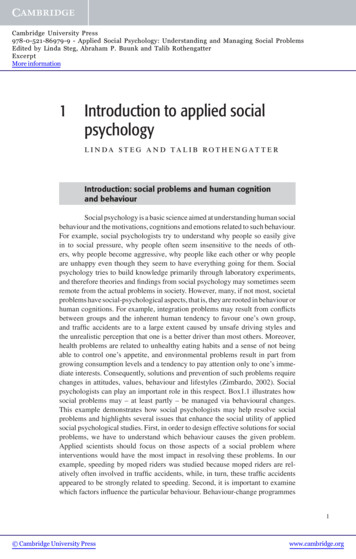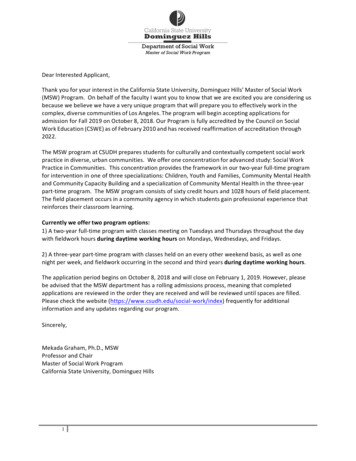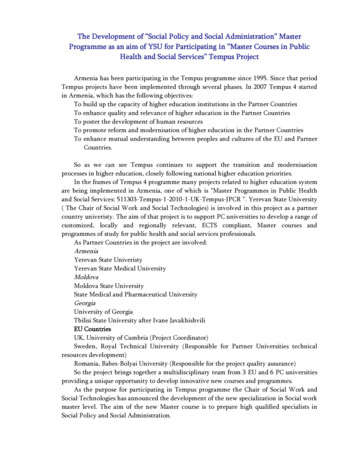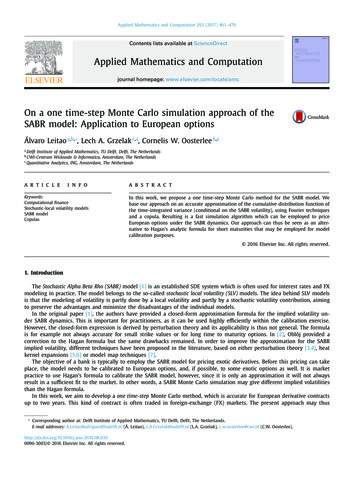
Transcription
Cambridge University Press978-0-521-86979-9 - Applied Social Psychology: Understanding and Managing Social ProblemsEdited by Linda Steg, Abraham P. Buunk and Talib RothengatterExcerptMore information1Introduction to applied socialpsychologyl i n d a s t e g a n d ta l i b r o t h e n g at t e rIntroduction: social problems and human cognitionand behaviourSocial psychology is a basic science aimed at understanding human socialbehaviour and the motivations, cognitions and emotions related to such behaviour.For example, social psychologists try to understand why people so easily givein to social pressure, why people often seem insensitive to the needs of others, why people become aggressive, why people like each other or why peopleare unhappy even though they seem to have everything going for them. Socialpsychology tries to build knowledge primarily through laboratory experiments,and therefore theories and findings from social psychology may sometimes seemremote from the actual problems in society. However, many, if not most, societalproblems have social-psychological aspects, that is, they are rooted in behaviour orhuman cognitions. For example, integration problems may result from conflictsbetween groups and the inherent human tendency to favour one’s own group,and traffic accidents are to a large extent caused by unsafe driving styles andthe unrealistic perception that one is a better driver than most others. Moreover,health problems are related to unhealthy eating habits and a sense of not beingable to control one’s appetite, and environmental problems result in part fromgrowing consumption levels and a tendency to pay attention only to one’s immediate interests. Consequently, solutions and prevention of such problems requirechanges in attitudes, values, behaviour and lifestyles (Zimbardo, 2002). Socialpsychologists can play an important role in this respect. Box1.1 illustrates howsocial problems may – at least partly – be managed via behavioural changes.This example demonstrates how social psychologists may help resolve socialproblems and highlights several issues that enhance the social utility of appliedsocial psychological studies. First, in order to design effective solutions for socialproblems, we have to understand which behaviour causes the given problem.Applied scientists should focus on those aspects of a social problem whereinterventions would have the most impact in resolving these problems. In ourexample, speeding by moped riders was studied because moped riders are relatively often involved in traffic accidents, while, in turn, these traffic accidentsappeared to be strongly related to speeding. Second, it is important to examinewhich factors influence the particular behaviour. Behaviour-change programmes1 Cambridge University Presswww.cambridge.org
Cambridge University Press978-0-521-86979-9 - Applied Social Psychology: Understanding and Managing Social ProblemsEdited by Linda Steg, Abraham P. Buunk and Talib RothengatterExcerptMore information2applied social psychologyBox 1.1Solving social problems via changing cognitions and behaviourSocial problemThe Province of Drenthe (in the north of the Netherlands) is concerned abouttraffic safety in the region. Researchers analysed the local traffic statistics, andfound that moped riders are twenty-two times more likely to be involved intraffic accidents than average road users (including pedestrians), and fortytimes more likely than average car users. Based on this, they decided todevelop a traffic safety programme aimed to increase the safety of mopedriders. They first decided to commission a study in which they examinedwhich factors underlie the high accident involvement of moped riders.Which behaviour causes accidents?The research team first examined which behaviour causes accidentinvolvement of moped riders. It appeared that traffic accidents are especiallyrelated to traffic violations (e.g., speeding), and not to errors (e.g., byaccident not giving priority) or lapses (e.g., not noticing a traffic light) madeby moped riders. Therefore, the research team decided to focus on factorsaffecting traffic offences. More specifically, they decided to focus onspeeding, because the survey study revealed that moped riders generally donot obey speed limits, and they are quite often fined for speeding. Theresearch team assumed that speeding typically results from consciousdecision making. Therefore, they based their study on a theoretical modelthat aims to explain planned behaviour that is under volitional control: thetheory of planned behaviour (TPB) (Ajzen, 1991; see Chapter 2).Factors influencing traffic violationsFollowing the TPB, the research team examined to what extent speedingwas related to attitudes towards speeding (i.e., the degree to which a personhas a favourable or an unfavourable evaluation or appraisal of speeding),social norms (i.e., the individual’s perception of the extent to whichimportant others would approve or disapprove of speeding) and perceivedbehavioural control (i.e., the perceived ease or difficulty of (not) speeding). Itappeared that moped riders having positive attitudes and strong socialnorms towards speeding were more likely to violate speed limits than thosewith negative attitudes and weak social norms. Perceived behaviour controlwas not significantly related to speeding.Policies to increase traffic safetyBased on these results, the research team concluded that traffic safetyprogrammes could best focus on changing attitudes and social norms Cambridge University Presswww.cambridge.org
Cambridge University Press978-0-521-86979-9 - Applied Social Psychology: Understanding and Managing Social ProblemsEdited by Linda Steg, Abraham P. Buunk and Talib RothengatterExcerptMore informationIntroduction to applied social psychology3towards speeding. Among other things, they suggested stressing the risksassociated with speeding, so as to make prevalent attitudes more negative.Although the study revealed that moped riders do acknowledge these risks,it appeared that these risks did not outweigh the advantages of trafficoffences, such as feelings of freedom and the ‘kick’ out of not respecting thelaw. Also, the research team suggested presenting examples of youngsterswho disapprove of speeding in information campaigns, so as to weakensocial norms.will be more effective to the extent to which they target important antecedents ofbehaviour. Thus, we need to understand which factors cause behaviour. Third, itis important to understand which intervention techniques are available to changebehaviour, taking into account which behavioural antecedents are typically targeted by various intervention techniques. In our example, speeding appearedto be strongly related to attitudes and social norms. Thus, interventions shouldbest focus on changing attitudes and social norms related to speeding, for example, by designing information campaigns that stress the risks associated withspeeding. The involvement of applied social psychologists does not need to stophere. Applied social psychologists can also play an important role in evaluatingthe effects of interventions, by examining to what extent interventions indeedchange behaviour and the underlying determinants, and whether social problemsare indeed resolved. This will not only reveal whether intervention programmesare successful, but also how they may be improved. Moreover, evaluation studies provide unique opportunities to test social psychological theories in real-lifesettings.In sum, applied scientists should focus their efforts on aspects of a social problem where they would have the most impact in improving the relevant problems.This basic principle should be taken into account when deciding which problemto study (in our example: traffic safety of moped riders), which variables to concentrate on (in our example: causes of traffic violations) and the decision on whatkind of interventions to use in managing the problem (in our example: changingattitudes and norms).This book aims to provide an introduction to the contribution of social psychology to the understanding and managing of various social problems, and themethods used to achieve this. The book gives an overview of a wide range of socialpsychological theories, intervention techniques and research designs that can beapplied to better understand and manage social problems. Moreover, the bookaims to demonstrate how knowledge from social psychology has been applied inpractice. When discussing the role of social psychologists in ameliorating socialand practical problems, we highlight the role of human behaviour in various socialproblems, factors influencing such behaviour and effective ways to change theparticular behaviour. Cambridge University Presswww.cambridge.org
Cambridge University Press978-0-521-86979-9 - Applied Social Psychology: Understanding and Managing Social ProblemsEdited by Linda Steg, Abraham P. Buunk and Talib RothengatterExcerptMore information4applied social psychologyDefinition of applied social psychologyBefore elaborating on how social psychologists can contribute to resolving social problems, we will first define the field. Given the broad range of interestsof social psychologists, as will become apparent from the second part of this book,it is not easy to provide a formal definition of social psychology. However, in general, social psychologists seek to acquire basic knowledge about how people thinkabout, feel about, relate to and influence one another, and why they do so. Thus,social psychology may be defined as the scientific field that seeks to understandthe nature and causes of individual behaviour and thought in social situations.This includes, for example, behaviour and thoughts related to helping, attraction,conflict, prejudice, self-esteem, group processes and social exclusion (Baron &Byrne, 2004).Applied social psychology, in turn, may be defined as the systematic application of social psychological constructs, principles, theories, intervention techniques, research methods and research findings to understand or ameliorate socialproblems (Oskamp & Schultz, 1998). Constructs are the building blocks of psychological principles and theories. A construct refers to a clearly defined individual (psychological) characteristic that is generally latent and thus not directlyobservable, although it can be assessed through interviews or questionnaires.Examples are attitudes (i.e., whether one evaluates a topic positively or negatively), values (i.e., general beliefs about desirable behaviour or goals) or socialnorms (i.e., whether one’s social group disapproves or approves of a particularbehaviour).A principle is a statement of how a psychological process works. Principlesdescribe basic processes by which humans think, feel and act. Examples are:r The foot-in-the-door technique, which involves making a small initial request,followed by a larger related request within a short period (Figure 1.1); generally,those who agreed to the small request are much more likely to comply withthe larger request as well, as compared with those who were not asked to agreewith a small request or to those who did not agree to the small request.r Cognitive dissonance, which refers to the uncomfortable tension that can resultfrom having two conflicting thoughts at the same time, or from engaging inbehaviour that conflicts with one’s beliefs or attitudes (Figure 1.2). When twocognitions (including beliefs, emotions, attitudes, behaviour) are incompatible,individuals try to reduce this dissonance by inventing new thoughts or beliefs,or by modifying existing beliefs.r The availability heuristic, which refers to the tendency to judge the likelihoodor frequency of an event by the ease with which relevant instances come tomind.A theory is an integrated set of principles that describes, explains and predictsobserved events. Theories provide explanations for our observations, and enable Cambridge University Presswww.cambridge.org
Cambridge University Press978-0-521-86979-9 - Applied Social Psychology: Understanding and Managing Social ProblemsEdited by Linda Steg, Abraham P. Buunk and Talib RothengatterExcerptMore informationIntroduction to applied social psychology5Figure 1.1 Foot-in-the-door techniqueFigure 1.2 Cognitive dissonance reductionus to predict future events. A theory integrates various principles. An exampleis the theory of planned behaviour, described in Box 1.1. Theories are not factsor laws; the tenability of theories should be tested in practice. We elaborate onrelevant theories, intervention techniques and research designs in Chapters 2, 3and 4, respectively. Cambridge University Presswww.cambridge.org
Cambridge University Press978-0-521-86979-9 - Applied Social Psychology: Understanding and Managing Social ProblemsEdited by Linda Steg, Abraham P. Buunk and Talib RothengatterExcerptMore information6applied social psychologyBasic and applied social psychology differ in two important respects.1. Basic social psychologists are particularly interested in developing and testing theories, while applied social psychologists focus on understanding andresolving practical problems. Basic social psychologists may conduct studies merely out of scientific curiosity about some phenomenon, while appliedsocial psychologists are specifically trying to contribute towards solving socialproblems. In the end, applied social psychologists will focus their efforts on theimprovement of people’s quality of life. They do not necessarily have to conduct studies themselves to learn more about phenomena causing the problemsat hand. In some cases, available knowledge may be sufficient to plan interventions or social programmes that would ameliorate these problems. Does thisimply that applied social psychologists do not contribute to the developmentof theories at all? No, it does not. Rather, theory development is not their maininterest; it is not the primary reason that they do research.2. Basic social psych
Basic and applied social psychology differ in two important respects. 1. Basic social psychologists are particularly interested in developing and test-ing theories, while applied social psychologists focus on understanding and resolving practical problems. Basic social psychologists may conduct stud- ies merely out of scientific curiosity about some phenomenon, while applied .











